Grenades (silicates): Almandine
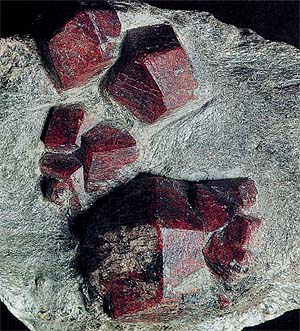 Diagnostic card.
Diagnostic card.
On the picture. Crystals of almandine in shale rock (Jotzal, Austria).
Fe 3 Al 2 (SiO 4 ) 3
Cubic amount of cubic zirconia
Hardness 7-7,5
Specific weight 4,3
Cleavage is absent
Cracked shell
Color violet-red, brown-red
Color in powder white
Shine from glass to resin

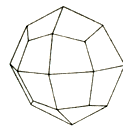
His name was given to the Almandin through the city in Asia Minor. To better reveal the color of the stone, when it is processed in the cabochon from the underside, a depression is made. Almandine with the effect of asterism is called a star grenade. The most significant deposits of jewelry almandine are known in Sri Lanka, India, Afghanistan, Brazil, Austria and the Czech Republic.
Crystals of almandine are rhombododecahedrons and tetragon-trioctahedra, both forms often combined, sometimes round. Coloring is violet-red and brownish-red, less often orangeish-red. Glitter is glass and resin. Almandin is the hardest of all pomegranates, it has no cleavage, medium fragility, fractured shell. Large or small well-formed crystals, grains and their aggregates, ellipsoidal nodules and solid masses with a shell-like structure. Etching is observed on the crystals in the form of triangles, the faces are sometimes slightly shaded; On the faces of almandine crystals from metamorphic schists and sedimentary rocks of the Carpathians and the Carpathian Mountains there are steps of growth.
Almandine with a small content of Ca and Mg was called calcium pyrimandine (calc-pyralmandine), with a small content of Mn - manganese almandine, manganalmandine (manganalmandine). There is a continuous isomorphic series from almandine to pyrope and from almandine to spessartine.
Pure almandines of the composition Fe3Al2 [SiO4] 3 are rare, most often there is a pyrope component, as well as impurities of ions Fe3 +, Ca2 +, Mn2 +, etc. The color of the almandine is primarily associated with Fe2 + ions, with a decrease in the concentration of which there is some attenuation of color Stone, reducing its density. The presence of Fe3 + and Mn2 + ions leads to the appearance of red and orange hues in the almandines.
Almandine is usually found in the form of well-formed crystals - rhombododecahedrons, trigonotroctahedra, often with shading on the faces. The size of crystals from fractions to several tens of centimeters, but crystals of jewelry quality are usually small - 5-6 mm. Larger crystals are rare. At the Smithsonian Institution in the United States, a star almandine is stored. Idaho (USA) with a mass of 174 ct.
Diagnostic signs.
Sometimes it is characterized by weak magnetic properties. Inside, there may be rutile needles, which cause the effect of asterism, which manifests itself in the form of the appearance of a light asterisk. Fused into a dark magnetic ball. Does not dissolve in acids.
Origin.
It is formed mainly in metamorphic shale rocks, in granite pegmatites, as well as in igneous rocks of basic composition. The deposits of almandine are confined primarily to alluvial, eluvial and, to a lesser extent, to coastal-marine placers associated with erosion of metamorphic rocks-crystalline schists and gneisses of the almandine-amphibolite facies, microcline muscovite-beryl pegmatites and effusives of medium and acidic composition.
Place of Birth.
The best known deposits of India and Sri Lanka. Other significant deposits of almandine are in Brazil, South America and Madagascar. The best almandines are famous for Sri Lanka. Good stones are supplied by India and Brazil. There are almandines in the USA (Alaska, Fort-Wrangell, the states of Colorado, South Dakota, Michigan, New York, Pennsylvania, Connecticut, Maine, California), Canada, Austria, Japan, Tanzania, Zambia and Madagascar. In the CIS almandines are known since the 18th century - on the Kola Peninsula, in Karelia, in the Southern Urals, in Eastern Siberia (along the Mama River). The largest deposits are the Kientelskoe (on the shores of Ladoga Lake) and Chupinskoye.
Use in jewelry.
Almandine is treated with facets in the form of a mixed cut or rosette, sometimes in the form of a cabochon; In the past they made a depression in the middle of the stone to reduce the color saturation.
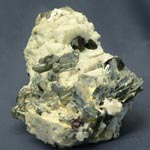
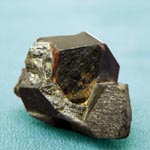
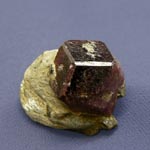
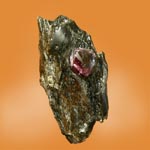
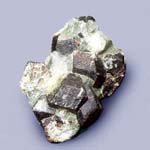
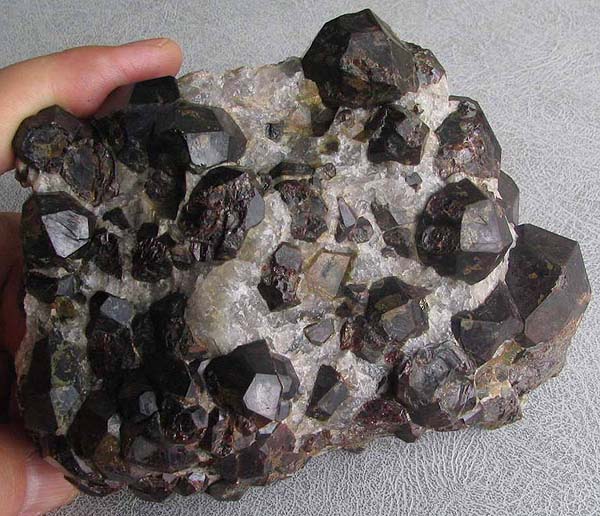
Almandin in the quartz. Petrovsky district. Krivorozhye, Ukraine. Photo: © А.А. Evseev.
- Ghetchellit - "New Almaden blend" - arsenide and antimony sulfide (modern sulfosol)
- Antimony is a toxic metal (semimetal) , widely used in metallurgy, medicine and engineering
- Zirconium - a rare and undiscovered metal and the most dangerous precious stone in oxide and salt
- Gold - yellow dangerous and poisonous metal of modern accurate digital and cable technologies
- Sulfur is a golden-yellow toxic substance and a sign of active volcanic activity
- Cadmium is an undisputed toxic silvery metal unknown to a wide range of people
- Lead - a toxic gray imitator of metallic silver and toxic metal blende
- Arsenic is a classic poison of medieval and modern poisoners and medicine in medicine
Poisonous and radioactive dangerous stones and minerals
** - poisonous stones and minerals (mandatory check in the chemical laboratory + explicit indication of toxicity)
** - radioactive stones and minerals (mandatory check on the standard dosimeter + ban on open sales in case of radioactivity exceeding 24 milli / g / h + additional measures of population protection)
Catalog of minerals and semi-precious stones of the world by groups
** - poisonous stones and minerals
** - radioactive stones and minerals


Comments
When commenting on, remember that the content and tone of your message can hurt the feelings of real people, show respect and tolerance to your interlocutors even if you do not share their opinion, your behavior in the conditions of freedom of expression and anonymity provided by the Internet, changes Not only virtual, but also the real world. All comments are hidden from the index, spam is controlled.